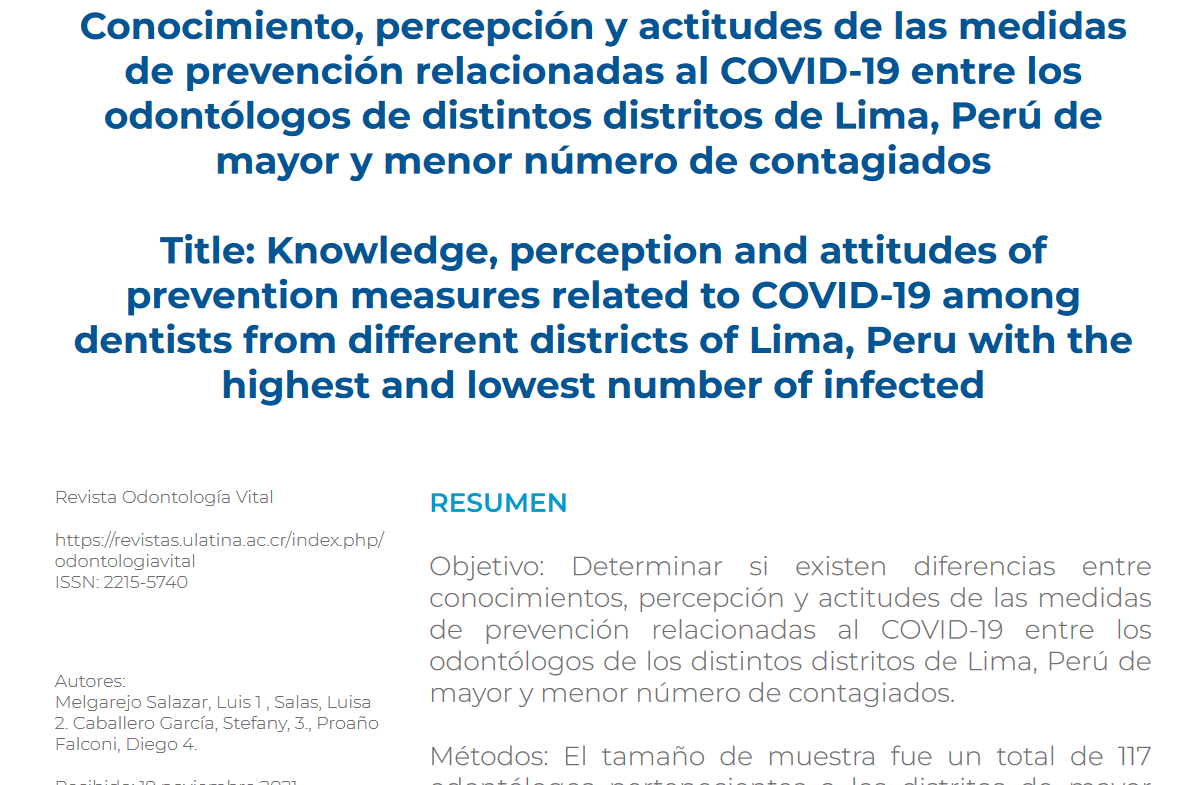Knowledge, perception and attitudes of prevention measures related to COVID-19 among dentists from different districts of Lima, Peru with the highest and lowest number of infected
DOI:
https://doi.org/10.59334/ROV.v1i36.466Abstract
Objective: To determine if there are differences between knowledge, perception and attitudes of the prevention measures related to COVID-19 among the dentists of the different districts of Lima, Peru with the highest and lowest number of infection cases.
Methods: The sample size was 265 dentists, of which 117 were from the districts with the greatest impact and 148 from the districts with the least impact. These districts of both extremes were based on the contagion rates that they presented in August 2020 according to the Ministry of Health. A questionnaire was used as an instrument and it was distributed via social networks. For the univariate analysis, the descriptive statistics were obtained where the absolute and relative frequency measures were calculated for the dependent, independent and covariate variables. For the bivariate analysis, a comparison was made between the variable’s knowledge, perception and attitudes with the dentists of the districts with the highest and lowest number of infected using the Chi-square test.
Results: The dentists of the districts with the highest impact have greater knowledge about the main symptoms, transmission routes and prevention measures against COVID-19 compared to the dentists of the districts with the least impact. In addition, those with the greatest impact perceive COVID-19 as very dangerous, while those with the least impact perceive it as moderately dangerous and very dangerous in equal proportions. Finally, with regard to attitude, those with the greatest impact do not care for a suspicious patient and refer him to a health center, while those with the least impact do care for them and refer them to a health center.
Conclusion: Finally, differences were found between knowledge, perception and attitudes of the prevention measures related to COVID-19 among the dentists of the different districts of Lima, Peru with the highest and lowest number of infected people.
Downloads
References
Álvarez, B. y Juna J. (2017). Conocimientos y prácticas sobre bioseguridad en odontólogos de los centros de salud de
Latacunga. Enferm. Inv. 2(2):59-63. https://revistas.uta.edu.ec/erevista/index.php/enfi/article/view/455/733
Barbosa, D., Agudelo, A,. Tuesta, M, Ariza, J., y Plaza S. (2021). Dental practice modification, protocol compliance and risk
perception of dentists during COVID-19 pandemic in Colombia: a cross-sectional study. Rev Fac Odontol Univ Antioq. 33(1),
-35. https://revistas.udea.edu.co/index.php/odont/article/view/343942
Borja, C., Gómez, C., Alvarado, E., Bernuy, L. (2020). Conocimiento sobre la enfermedad por coronavirus (COVID-19) en
odontólogos de Lima y Callao. Rev Cient Odontol (Lima). 8(2). https://revistas.cientifica.edu.pe/index.php/odontologica/article/view/696/699
Colegio Odontológico del Perú. (2020). Protocolo de bioseguridad para el cirujano dentista durante y post pandemia COVID-19.COP. http://www.cop.org.pe/wp-content/uploads/2020/04/PROTOCOLO-DE-BIOSEGURIDAD-PARA-EL-CIRUJANO-DENTISTA.pdf
Coulthard, P. (2020) Dentistry and coronavirus (COVID-19) - moral decision-making. Br Dent J 228. 503–505. https://pubmed.ncbi.nlm.nih.gov/32277203/
Eloiza, M., Angela, G., Thamiris, P., Conrado, D y Karla, L. (2021). El conocimiento de los profesionales y alumnos de odontología sobre la hepatitis B y C. BJHR. 4:(2). https://www.brazilianjournals.com/index.php/BJHR/article/view/27272
Enrique, N y Diana, C. (2020). Conocimiento y preparación de los odontólogos mexicanos ante la pandemia por COVID-19.
Revista ADM. 77 (3): 129-136. https://www.medigraphic.com/pdfs/adm/od-2020/od203c.pdf
Habas, K., Nganwuchu, C., Shahzad, F., Gopalan, R., Haque, M., Rahman, S., Majumder, A y Nasim T. (2020). Resolution of
coronavirus disease 2019 (COVID-19). Expert Rev Anti Infect Ther. 18(12):1201-1211. https://pubmed.ncbi.nlm.nih.gov/32749914/
Han, P., Pang, T., Diao, K y Yang Z. (2020). Corona Virus Disease 2019 (COVID-19): the image tells the truth. Infection. 48(6):981-984. https://pubmed.ncbi.nlm.nih.gov/32385842/
Long, M. y Aye Y. (2021). Science’s Response to CoVID-19. ChemMedChem. 16(15):2288-2314. https://pubmed.ncbi.nlm.nih.
gov/33811458/
Majumder, J y Minko, T. (2020). Recent Developments on Therapeutic and Diagnostic Approaches for COVID-19. AAPS J.
;23(1):14. Disponible en: https://pubmed.ncbi.nlm.nih.gov/33400058/
Ministerio de Salud. (2020). Situación actual COVID-19 Perú. MINSA. [Internet]. https://www.dge.gob.pe/portal/docs/tools/
coronavirus/coronavirus290820.pdf
Mughees, M., Chugh, H, Naqvi, S y Wajid, S. (2021) COVID-19 Threat to the World: Current and Possible Diagnostic/Treatment Strategies. Crit Rev Biomed Eng. 49(1):21-33. https://pubmed.ncbi.nlm.nih.gov/34347985/
Pares, G y Rodríguez, Y. (2021). Repercusiones de la pandemia COVID-19 en los ingresos y egresos económicos del odontólogo general. Odontol Sanmarquina 23(4):409-18. https://revistasinvestigacion.unmsm.edu.pe/index.php/odont/article/view/19103
Quiceno, J y Vinaccia, S. (2010). Percepción de Enfermedad: Una aproximación a partir del Illness Perception Questionnaire.
Psicología desde el Caribe. 25:56-83. https://www.redalyc.org/pdf/213/21315106004.pdf
Stefani, A., Bruno, G., Mutinelli, S y Gracco, A. (2020). COVID-19 outbreak perception in Italian dentists. Int J Environ Res Public Health. 17(11). https://pubmed.ncbi.nlm.nih.gov/32485959/
Surani, S. (2021). COVID-19 pandemic: from origins to outcomes. A comprehensive review of viral pathogenesis, clinical
manifestations, diagnostic evaluation, and management. Infez Med. 29(1):20-36. https://pubmed.ncbi.nlm.nih.gov/33664170/
Umakanthan, S y Kumar, H. (2020). Origin, transmission, diagnosis and management of coronavirus disease 2019 (COVID-19). Postgrad Med J. 96(1142):753-758. https://pubmed.ncbi.nlm.nih.gov/32563999/
Khader, Y., Mohannad,A., Al Nsour., Ola, B., Al-Batayneh, Rami, S, Haitham, A., Alfaqih, A., et al. (2020). Dentists’ awareness,
perception, and attitude regarding COVID-19 and infection control: A cross- sectional study among Jordanian dentists. JMIR
Public Health and Surveill. 9;6(2). https://www.ncbi.nlm.nih.gov/pmc/articles/PMC7147327/
Yüce, M., Filiztekin, E y Özkaya, K. (2020). COVID-19 diagnosis -A review of current methods. Biosens Bioelectron. 172:112752. https://pubmed.ncbi.nlm.nih.gov/33126180/

Published
How to Cite
License
Copyright (c) 2022 Luis Fernando Melgarejo Salazar, Luisa Salas, Stefany Caballero-García , Diego Proaño Falconi

This work is licensed under a Creative Commons Attribution 4.0 International License.
Authors who publish with Odontología Vital agree to the following terms:
- Authors retain the copyright and grant Universidad Latina de Costa Rica the right of first publication, with the work simultaneously licensed under a Creative Commons Attribution 4.0 International license (CC BY 4.0) that allows others to share the work with an acknowledgement of the work's authorship and initial publication in this journal.
- Authors are able to enter into separate, additional contractual arrangements for the non-exclusive distribution of the Odontología Vital's published version of the work (e.g., post it to an institutional repository or publish it in a book), with an acknowledgement of its initial publication.
- Authors are permitted and encouraged to post their work online (e.g., in institutional repositories or on their website) prior to and during the submission process, as it can lead to productive exchanges, as well as earlier and greater citation of published work.
Métricas alternativas










